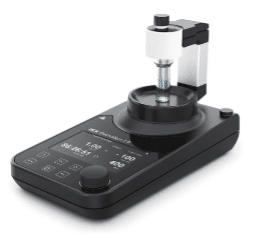Electrochemistry is a powerful tool within the realm of organic synthesis, providing an invaluable means for the activation and derivatization of molecules in the search for novel pharmaceutically relevant structures. Our scientists at Symeres have considerable expertise and experience in harnessing the potential of electrochemistry to drive our clients’ projects.
In our pursuit of novel compounds, we use the IKA ElectraSyn 2.0 that allows us to rapidly explore reaction conditions for a range of electrochemical transformations. This technology enables precise control of reaction parameters, such as current, voltage, and electrode material, facilitating a streamlined and efficient screening process. At Symeres, we leverage these reactions for the efficient synthesis of complex intermediates and final products for our clients.

The advantages of electrochemistry are multifaceted:
Selectivity: Electrochemical reactions often exhibit remarkable selectivity, enabling the targeted modification of specific functional groups or regioselective transformations.
Sustainability: Electrochemical transformations are usually performed under mild conditions, reducing the need for harsh reagents, and minimizing the production of waste. This is in line with our commitment to sustainable and environmentally responsible chemistry.
Functional Group Tolerance: Electrochemical reactions tolerate a range of functional groups, allowing for the modification of complex molecules minimizing the risk of side reactions or undesirable byproducts.
Inspired by literature such as that published by Tim Noël, Phil Baran, and many others, electrosynthetic methodologies applied in our research now include the direct C(sp3) fluorination of complex molecules, desaturation of ketones, and mild aromatization conditions.
Reactions in our toolbox include C–H activation via the Shono oxidation of tertiary and secondary N-carbamates, amides, and lactams, or non-Kolbe decarboxylation as an efficient way to incorporate three dimensionality and complexity to simple substrates. These reactions have been applied to both the early and late-stage derivatization of natural product-like structures and known lead-like analogs. After optimization on a small scale, these conditions were utilized in the synthesis of many substrates on multimole scales using our electrochemical reactors.

Multivial screening setup for electrochemical reactions using the ElectraSyn 2.0 package
An example of the synthesis of a building block is depicted in the scheme below. This reaction was performed on 0.5 kg scale in our custom-built multipurpose reactor using the following conditions:

By employing electrochemistry, we enhance our clients’ capacity to explore innovative pathways for the synthesis of pharmaceutically relevant compounds and ultimately help drive the development of novel pharmaceuticals.
Contact our electrochemistry experts directly to learn more about our electrochemical capabilities.
